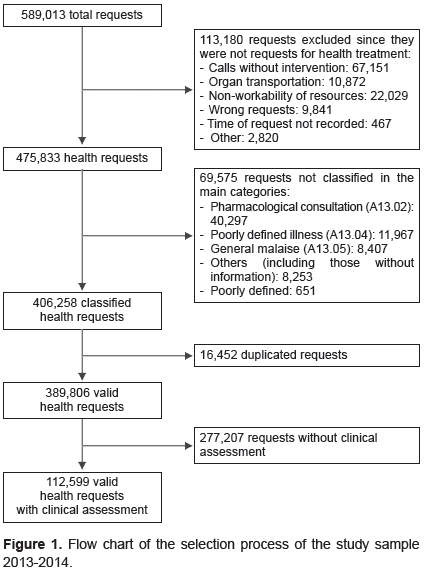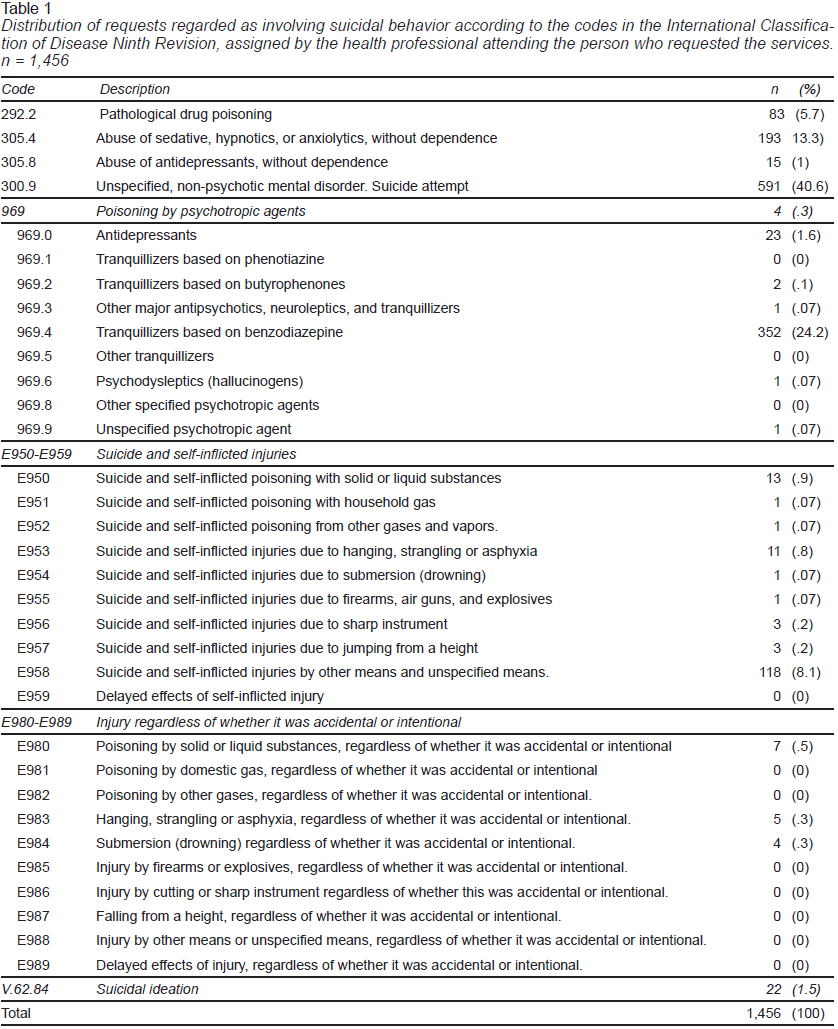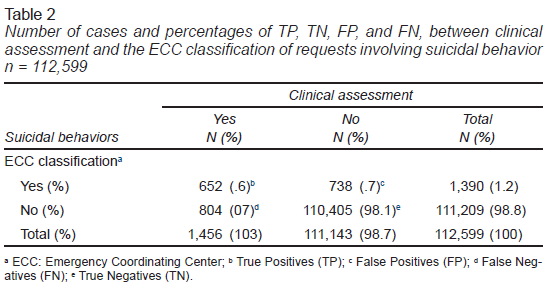Introduction
Suicide is a public health problem, causing over 800,000 deaths worldwide every year (World Health Organization [WHO], 2019). In Spain, a total of 3,539 suicide deaths were registered in 2018, equivalent to a suicide rate of 7.9 per 100,000 inhabitants (Instituto Nacional de Estadística [INE], 2019). However, these figures only consider actual suicide deaths and do not include suicide attempts. It is estimated that for every suicide death, there are 20 previous attempts (WHO, 2014), which are the most predictive risk factor for suicidal behavior (Parra-Uribe et al., 2017).
Since most people who attempt suicide go to out-of-hospital Emergency Services (OES), it is essential to study the classification and correct registration of suicide attempts in the latter. However, scientific literature, although scant, has focused on studying the validity of triage systems that determine the level of priority of Hospital Emergency Service (HES) requests (Feldman et al., 2006; Grosgurin et al., 2019; Parenti, Bacchi Reggiani, Iannone, Percudani, & Dowding, 2014; Williamson, Gochman, Bullaro, Kaufman, & Krief, 2018). Although their use can be extrapolated to OES (Gräff et al., 2014), there has been less research in this respect, especially as regards mental problems (Shah et al., 2009) and particularly suicide.
In Andalusia, the largest autonomous community in Spain, various research projects have focused on the analysis of requests related to suicidal behavior (Blanco-Sánchez et al., 2018; Mejías-Martín et al., 2018; 2019) and observed that the highest rate occurs in the province of Málaga. Studies conducted in this province have found differential characteristics in requests related to suicidal behavior with respect to other OES requests (Guzmán-Parra et al., 2016; Jiménez-Hernández et al., 2017; Moreno-Küstner et al., 2019). However, results obtained in previous studies reveal differences in the classification of suicide attempts (Blanco-Sánchez et al., 2018; Guzmán-Parra et al., 2016; Jiménez-Hernández et al., 2017; Mejías-Martín et al., 2018; 2019; Moreno-Küstner et al., 2019). Some studies classify a request as involving suicidal behavior when the operator answering the call and the doctor attending the patient consider it as such (Mejías-Martín et al., 2018; 2019; Moreno-Küstner et al., 2019). However, others have regarded requests related to suicidal behavior by using merely the classification made by the operator (Guzmán-Parra et al., 2016; Jiménez-Hernández et al., 2017). Furthermore, Blanco-Sánchez et al. (2018) observed enormous difficulty on the part of health professionals in classifying suicide attempts due to the implications this entails, since it is one of the behaviors with the lowest registration rate in health reports (Miret et al., 2010).
These circumstances justify the need for a valid classification system of OES requests. For this reason, and due to the importance of having a useful classification to improve care provision, the general objective of this study is to validate the classification of the Emergency Coordinating Center (ECC) of Málaga (Spain), based on its sensitivity, specificity, and positive (PPV) and negative (NPV) predictive values for the detection of requests related to suicidal behavior.
Method
The mechanics of the ECC
To meet out-of-hospital demands, Andalusia has a network managed through the Public Health Emergency Corporation (PHEC). The various programs are coordinated by the Emergency Coordinating Centers (ECC) located in each of the Andalusian provinces, all of whom classification systems are similar. Requests are registered on the basis of the information received by telephone. The telephone operator asks a series of questions according to a protocol established for each type of request, supervised by the coordinating doctor, to choose the best resource according to the reason for the call (Servicio Andaluz de Salud, 2018). Proper care for these users requires assigning a priority level based on a triage system according to severity: emergency, urgent emergency, non-urgent emergency, and household notifications (Guzmán-Parra et al., 2016).
Requests are classified at two separate times. The first corresponds to the ECC categorization made by the telephone operator at the time of answering the call, based on the following 14 categories: “Traffic accidents,” “Alteration of vital signs,” “Neurological disorders and/or alterations of level of consciousness,” “Dyspnea,” “Non-traumatic pain,” “Gastrointestinal,” “Gynecological/Obstetric/Urinary,” “Hemorrhages,” “Poisoning/Allergies,” “Psychiatric,” “Trauma,” “Environmental emergencies/External agents,” “Nursing needs,” and “Other unclassified.” The second moment is the clinical assessment by the professional who goes to the scene of the event to assist the user and is based on the International Classification of Diseases 9th Edition (ICD-9) (WHO, 1979).
Study design
This is a descriptive, cross-sectional study of requests related to suicidal behavior registered in the ECC database of the province of Málaga, received during 2013 and 2014.
Sample
The database analyzed comprised a total of 589,013 requests. To improve data quality, 113,180 requests were excluded since they were not health care requests, together with 69,575 claims that were not classified in the main categories. Furthermore, 16,452 duplicate requests were identified and eliminated. A total of 389,806 valid health claims were obtained, of which 277,207 were excluded because information on the clinical assessment by the health professional was not recorded in the database. Lastly, the sample consisted of 112,599 valid health requests that had been attended by a health professional at the scene of the event, for which the clinical assessment had been recorded (Figure 1).
Calculation of the sample size to obtain the necessary statistical power to generalize our results was based on the infinite population formula (Morales-Vallejo, 2012). Accordingly, for the sample to be representative in our case, 1,067 requests would be required.
Request classification
Two moments were considered in the process of classifying the requests. The first was the classification made by the ECC, and the second, the clinical assessment provided by the health professional. We regard the latter as a reference standard since we assume professionals have more information for classifying requests, since they attend patients in situ.
According to the ECC classification, requests related to suicidal behavior are classified by the operator as “a tendency to self-harm and suicide,” “suicide threats” and “suicidal ideas,” which are subcategories within the group of “Psychiatric” requests, which include all levels of suicidal behavior (from ideas to attempts).
Considering the clinical assessment by the healthcare professional who attends patients in situ, a request is regarded as involving suicidal behavior when it has been classified by the suicide codes (V62.84: Suicidal Ideas and E950-E959: Suicide and self-inflicted injuries) and those referring to drug poisoning, according to the selection made in the study by Mejías-Martín et al. (2018). We have also incorporated code 292.2: Pathological drug poisoning because this is frequently used in situations of possible suicide (Blanco-Sánchez et al., 2018; Fernández, García, Romero, & Marquina, 2008) and it is the main method used in previous suicide attempts (Pacheco Tabuenca & Robles Sánchez, 2011).
Statistical analysis
To validate the classification system used in the ECC for suicidal behaviors, sensitivity, specificity, and PPVs and NPVs were calculated, using clinical assessment as the reference standard.
Sensitivity is the probability that the system will correctly classify an individual who meets a certain criterion, according to the reference standard. Specificity refers to the ability of the system to detect cases that do not meet a certain condition according to the reference standard. Both are therefore intrinsic properties of the classification system and provide information on the probability of obtaining a result (whether positive or negative) based on the true state of the subject, which, in our case, is suicidal behavior classified according to clinical assessment, which makes it possible to assess the validity of the system. Both properties yield values ranging from 0-100%, with a higher percentage indicating greater sensitivity or specificity.
Predictive values show the certainty with which the ECC classification system will predict the presence or absence of a certain condition (Pita Fernández & Pértegas Díaz, 2003). The PPV refers to the probability of meeting a certain condition (a request related to suicidal behavior, according to our reference standard) if the ECC classification has categorized the request as involving suicidal behavior. NPV refers to the probability of failing to meet a certain condition (not a request related to suicidal behavior, according to our reference standard), and being classified by the ECC as non-suicidal behavior.
Ethical considerations
The study met the ethical research criteria and was approved by the Ethics and Research Committee of Northeast Málaga. The databases analyzed did not contain identifiable information on the patients (such as the National Identity Document and Health Card Number). In addition, all members of the research team signed a specific confidentiality commitment.
Results
Of the 112,599 valid health service requests, the mean age was 66.27 (SD = 21.18) while 52.4% (n = 58,976) of the requests were made by women. The total number of requests were divided into two groups: that of the ECC, when the patient is attended by telephone and that of the healthcare professional who attends in situ. The first group classified 1,390 requests (1.2%) as suicidal behavior; while the second classified 1,456 (1.3% as this type of behavior).
Table 1 shows the distribution of requests related to suicidal behavior according to the clinical assessment of the health professional who attends the patient at the scene of the event. The codes referring to mental disorders and poisoning are the most common diagnoses (40.6% and 24.2%, respectively), as opposed to the actual suicide codes, which account for 12% of the distribution.
Table 2 shows the results of the calculation of sensitivity, specificity, PPV, and NPV. The sensitivity of the classification system of the coordinating center to correctly identify requests related to suicidal behaviors, according to the reference pattern, was 44.78%, while the specificity of the classification system to detect the absence of suicidal behavior, according to the clinical assessment, was 99.34%. As for the PPV of requests related to suicidal behavior, a value of 46.91% was obtained and a value of 99.28% was obtained for the NPV (Table 3).
As can be seen from Table 2, 738 requests (.7% of the total) were regarded as false positives. In other words, the ECC classified them as suicide, but the healthcare professional who attended the user reported a different diagnosis. Eight hundred and four cases were considered false negatives (.7% of the total). These are requests that the coordinating center did not classify as suicide, whereas the health professional assigned them codes which meant they could be considered as suicidal behavior.
Discussion and conclusion
The purpose of this study is to validate the classification system of a coordinating center for urgent requests in comparison with the categorization made by doctors attending these requests in situ. The results obtained indicate that the ECC classification has a lower capacity to identify requests involving suicidal behavior than it has to detect the absence of suicidal behavior in the requests received. The strengths of this study include having a large set of data obtained from daily clinical practice and being able to compare the classification of requests at two different moments in the OES care process.
The results of the analysis of the sensitivity and specificity of the classification system used by the ECC have shown that it experiences difficulty in detecting demands for suicidal behavior. In this regard, Mejías-Martín et al. (2018) in their study on OES requests involving suicidal behavior have highlighted the lack of agreement between the demands classified by the ECC operator as suicide and the clinical assessment made by the healthcare team attending the patient. Their result showed that, out of the total number of requests identified as suicide by the operator, only 7.7% are confirmed as such by the doctor treating the patient. These findings can be explained by factors such as the lack of a specific protocol in the case of suicidal behavior to guide action (Mejías-Martín et al., 2018), the absence of a uniform classification system to categorize suicidal behavior (Silverman, Pirkis, Pearson, & Sherrill, 2014), and the difficulty in determining, for the professional who answers the phone, the intentionality of a suicide attempt when the circumstances are unclear or the patient cannot or does not wish to clarify matters (Blanco-Sánchez et al., 2018; Mejías-Martín, García-Caro, Schmidt, Quero, & Gorlat, 2011; Mejías-Martín et al., 2018). These factors, together with the great social stigma attached to suicide, suggest that they may be interfering in the accurate classification of requests as involving suicidal behavior.
As for the lack of agreement in the classification of requests between the operator and the doctor attending the patient in situ, we found, on the one hand, that requests regarded as false positives were mainly classified as a mental illness, according to our standard of reference. The presence of mental disorders is a risk factor, but it is hardly sufficient factor (Franklin et al., 2017) for suicidal behavior, and the causality of suicides due to a mental disorder has been widely disseminated (García-Haro et al., 2020), it seems logical to think that an ECC operator would classify a request as involving suicidal behavior when the patient verbalizes a related ideation or behavior. However, it is the onsite physician who can explore and undertake a more thorough evaluation of the patient’s condition and definitively considering the demand as a mental health problem.
Furthermore, requests considered false negatives were mostly classified as poisonings/allergies by the ECC. It is to be expected, given the information provided by the person requesting emergency health services that the operator will not have sufficient evidence to be able to consider the request as one involving suicidal behavior. Moreover, among the false negatives, requests classified by the ECC as trauma were found, which include falls and stab/fire wounds. This group of patients can be considered the most worrying as regards their treatment. Because ECCs classify them by severity, an inaccurate classification could lead to a delay in care-delivery.
In their qualitative study, Blanco-Sánchez et al. (2018) found that professionals who attend requests for emergency health services believe that there are no specific protocols for cases of suicide attempts. Requests concerning drug intake, for example, would be dealt with from a medical point of view regardless of whether it involves suicidal behavior. In this same study, since no objective elements were found to identify these behaviors as cries for attention or actual suicide attempts, the criteria of family members were often used to classify them as one or the other. In addition, ECC professionals consider that the health professionals who attend the patient should be responsible for classifying the request rather than them. Likewise, healthcare professionals consider that suicide attempts should be assessed in hospital services rather than the ECC. In this regard, the study by Moreno-Küstner and González Sánchez (2020) points to the underreporting of cases of suicide deaths in the Death Certificates with Judicial Intervention that provide information for the INE suicide statistics. Their results indicate that 73% of the cases of death were confirmed by family members as the suicide of the deceased person but were not identified as such in the Statistical Bulletin of Deaths with Judicial Intervention. This shows that the classification of suicidal behavior is an arduous, complicated task, and that proper registration by the various official bodies is required to obtain accurate suicide figures.
However, our study is not without limitations and its results should therefore be interpreted with caution. First, some requests were unable to be analyzed due to incomplete records. This underlines the fact that when working with the information extracted from daily clinical practice, intrinsic errors may appear during the data collection stage. Second, it was not possible to take patient variables (such as personal history and previous attempts) into account to be able to accurately classify an episode or call as a suicide attempt. Likewise, aspects such as gender and age could be potential sources of bias since the sample analyzed has a higher representation of older people and women, the groups that most request OES. Finally, in the future, we could encounter changes in the classifications used to date to record suicidal behavior. However, we consider that this limitation is always present since the methods and instruments used in research undergo changes and modifications to enhance their use.
This study has significant practical implications, such as, for example, serving to orient the training of OES professionals in the importance of conducting a more exhaustive classification of requests in general and those involving suicidal behavior in particular. In addition, better classification will allow for more effective, efficient interventions in suicide cases while at the same time facilitating the identification of cases regarded as false negatives, thereby reducing the unnecessary use of health resources.
In conclusion, we consider that it is necessary to have a valid classification system to identify requests involving suicidal behavior for pre-hospital emergency services, and to conduct periodic studies on the validity of this classification to improve care delivery. The use of categories or questions that are valid for identifying requests involving suicidal behavior will allow for better detection of this problem and help develop more suitable suicide prevention plans for this at-risk population.



